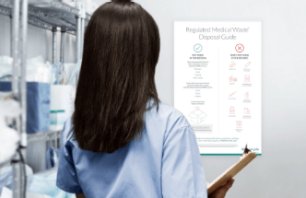Healthcare organizations in the United States produce millions of tons of medical waste every year. A portion of this waste is considered biohazardous or infectious, and, in most states, must be treated before being sent to a landfill or waste-to-energy facility. There are several different medical waste treatment approaches depending on the type of material being generated. The most common method of treatment, autoclaving, is a safe and effective way to protect communities and the environment.
What Is an Autoclave?
Autoclaves have a variety of uses depending on the type of business. In the healthcare industry, an autoclave uses high-pressure steam at controlled temperature and duration to kill pathogens, such as bacteria or viruses. This process renders the waste non-infectious prior to final disposal.
What Is an Autoclave Used for in Healthcare?
Autoclaves serve multiple critical functions within healthcare, such as the sterilization of instruments and equipment. Additionally, waste management firms employ autoclaves to process biohazardous and infectious waste prior to final disposal. The use of pressurized steam is recognized as one of the most efficient and effective techniques for treating medical waste.
How Does a Waste Management Company Use Autoclaves to Treat Medical Waste?
Medical waste companies will typically supply a Department of Transportation (DOT) compliant container for the transportation of the waste from the medical facility, or generator, to their facility. Once at the medical waste facility, waste will be managed in alignment with the facility’s permit conditions, usually set by the applicable state regulatory agency. The facility will weigh the waste and then prepare it to be processed through their autoclave.
How Do Autoclaves Work?
Once medical waste is placed in the bins that go inside the autoclave, air is evacuated from the vessel, creating negative pressure. Next, high-pressure, high-temperature steam is introduced for a defined duration, with validated parameters for time, temperature, and pressure established to effectively eliminate pathogens present in the waste. The combination of negative and positive pressure ensures thorough steam penetration, raising the internal temperature of the material rather than simply heating its surface. Effectiveness is verified through spore testing, which is described in detail below.
Operational temperatures typically range from 250 to 325 degrees Fahrenheit, with pressures between 40 and 80 PSI, depending on autoclave size and waste volume. Waste is typically kept at a high temperature and pressure for 20 to 30 minutes. Once the cycle is complete, steam is evacuated from the autoclave, the pressure is released, and the autoclave is now safe to open.
What Types of Medical Waste Can Be Autoclaved?
The majority of regulated medical waste can be treated through an autoclave. This may include soiled bandages, gauzes, personal protective equipment, or other items that are categorized as 'red bag' waste. Sharps, including needles and syringes, can also be processed in an autoclave.
However, some types of medical waste are not well suited for autoclaving, and it is recommended that these materials be separated out and processed by an alternative treatment technology, such as incineration. These materials could include pathological and trace chemotherapy waste.
It is also important that other wastes such as those which are considered hazardous waste under Environmental Protection Agency (EPA) Recourse Conservation Recovery Act (RCRA) regulations (e.g., organic solvents and laboratory chemicals) or radioactive wastes are never mixed with regulated medical waste. These types of waste are highly regulated and are not suitable to be treated through the regulated medical waste autoclaving process.
What Happens to Waste After Autoclaving?
After the autoclave treatment process, treated waste is typically compacted and sent to a landfill or waste-to-energy facility. Since the waste has been rendered non-infectious, it is safe to dispose of alongside other regular trash.
How Does Stericycle Check the Effectiveness of Autoclaves?
It is important that there are controls in place to ensure that the autoclave treats waste as intended. When the autoclave is initially set up, or any time the operating parameters are changed, the time, temperature and pressure must be validated with local regulatory authorities. Validating includes running a cycle and performing spore tests to confirm all waste is properly disinfected. Dual species spores, called Geobacillus stearothermophilus, are used to test the efficacy of its autoclaving process and to validate the appropriate settings. Due to the bacteria's high resistance to heat, it serves as a good indicator of microbial life after a steam cycle. Once validated, the approved parameters are programmed into the control system. Once this takes place, those parameters cannot be changed, except by going through the validation process again. Between each cycle, the operator confirms that each cycle ran properly and records this information in a daily log.
It is not uncommon for there to be requirements for quarterly, monthly or even weekly spore testing. Spore testing requirements may vary by state regulation or permit of the facility and should be done in accordance with the manufacturer’s specifications.
Why Choose Stericycle for Autoclaving and As Your Partner to Support Biohazardous Medical Waste Disposal
Learn more about Stericycle’s approach to medical waste processing and how Stericycle’s Biohazardous Medical Waste Disposal program can help you ensure compliance.



